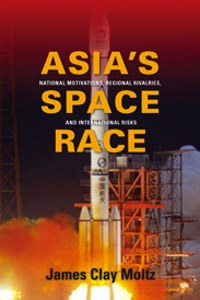Review: Asia’s Space Raceby Jeff Foust
|
| Unlike the bipolar competition between the United States and the former Soviet Union in the original space race a half-century ago, this environment features multiple races among China, India, Japan, and other emerging space powers in the region. |
Yet this analysis may oversimplify the situation. Very little in last week’s white paper represented new developments: Chinese officials had, on many occasions, previously discussed their plans for launch vehicle development and lunar exploration, as well as other satellite efforts. (The inclusion of human lunar missions in a formal government document may be mildly newsworthy, but the vague language and lack of a timetable suggest such missions are still far in the future, beyond 2020.) More importantly, though, is that the reaction to the white paper, including its underlying assumption of a competition between China and the United States in space, may be misplaced. While there may be elements of such a competition between those two countries, the bigger, and nearer-term, competition is among China and its neighbors in the Asia-Pacific region.
This emerging competition is the focus of the new book Asia’s Space Race by James Clay Moltz of the Naval Postgraduate School. As he notes in the book’s introduction, the title may be a bit of a misnomer: unlike the bipolar competition between the United States and the former Soviet Union in the original space race a half-century ago, this environment features multiple races among China, India, Japan, and other emerging space powers in the region. Each country has its own capabilities, interests, and goals in space, resulting in both competition and cooperation with each other and with other nations, including the US.
The bulk of the book examines the histories, technologies, and policies of the major Asian space powers, with one chapter each devoted to China, India, Japan, and up-and-coming South Korea; a fifth chapter looks at the various smaller space powers in the region, from Pakistan to Indonesia. Those sections are bookended by chapters that examine the bigger picture, including the interactions among those countries. “While China may be competing with the United States in space, it is equally interested in its relative place with respect to its Asian neighbors,” he writes in an introductory chapter reviewing national motivations and trends in the region. “Moreover, when China sprints forward in its space activity, there is no question that India, Japan, and South Korea all feel challenged and want to react.”
One key factor that Moltz expresses concern about in the book is the lack of cooperation among the major Asian space powers: China, India, and Japan are more likely to cooperate with non-Asian nations, like the US, Europe, and Russia, or with smaller Asian space powers, than with each other. That, coupled with “rapidly rising” military space spending by those countries, increases the risk of military confrontation in space among those nations, whose adverse impacts, like orbital debris from anti-satellite weapons, could affect all spacefaring nations. That risk, he argues, can be mitigated not just by improved cooperation among Asian nations, but with other nations as well, including the US; he expresses some optimism that this is possible. The lesson from Asia’s Space Race is that space remains a competitive environment among nations, but that competition is far more complex that the US-versus-China narrative in the media today.
